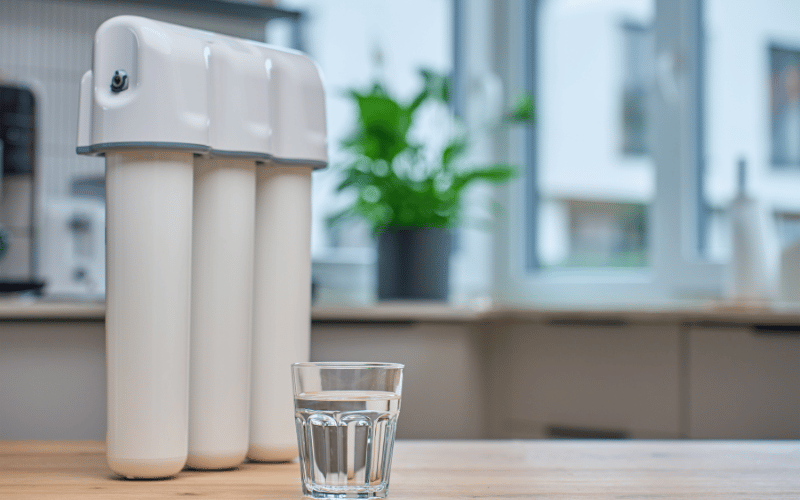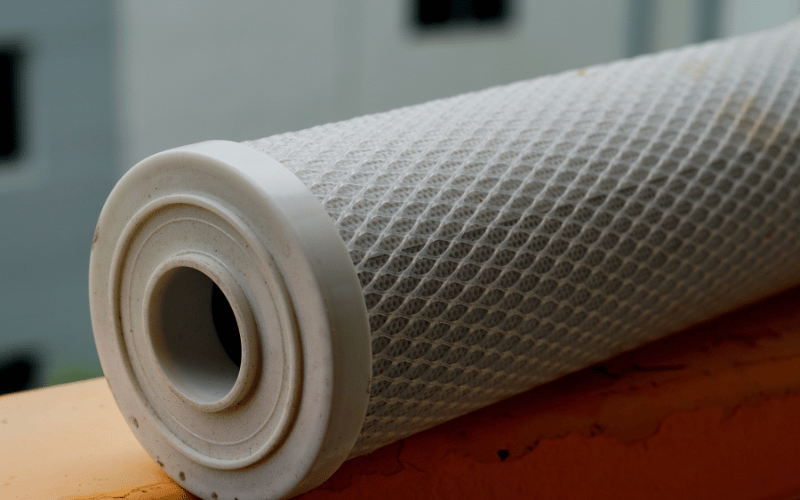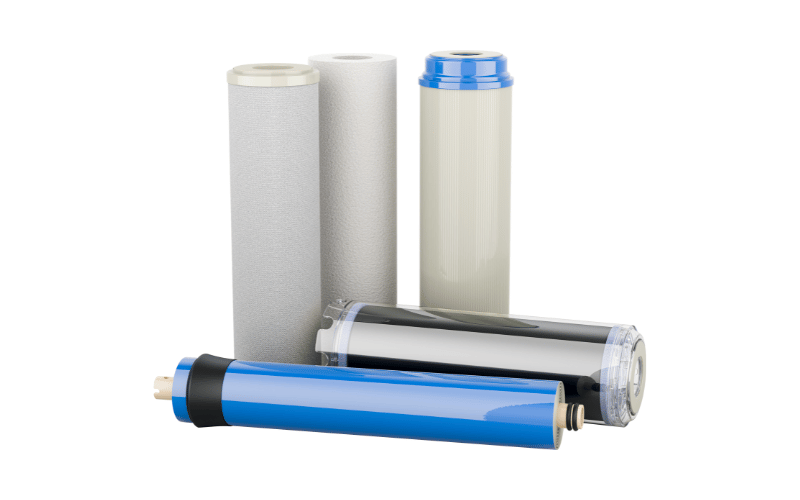Clean water is essential for both your health and the longevity of your home systems. Contaminants in water can affect everything from the taste of your drinking water to the efficiency of your appliances. Many homeowners face common water quality issues, such as sediment that clouds the water or unpleasant tastes and odors caused by chlorine or organic compounds. These problems not only impact daily life but can also lead to long-term damage to plumbing and fixtures if left unaddressed.
When it comes to water filtration, sediment and carbon filters stand out as two of the most effective solutions. Sediment filters focus on removing visible particles like sand, silt, and rust, ensuring that your water looks clean and doesn’t clog your pipes or appliances. On the other hand, carbon filters target invisible contaminants, improving taste and odor by removing chlorine, volatile organic compounds (VOCs), and other chemicals. Together, these filters address a wide range of water quality concerns, making them a popular choice for households and businesses alike.
In this guide, I’ll break down the differences between sediment and carbon filters, helping you understand their unique roles and how to choose the best option for your specific needs. Whether you’re dealing with murky water or an unpleasant aftertaste, the right filtration system can make all the difference.
Table of Contents
ToggleUnderstanding the Basics of Filtration
Filtration is the cornerstone of clean water, ensuring that what flows through your taps is safe, clear, and pleasant to use. To choose the right filtration system, you need to understand the distinct roles of sediment and carbon filters. Each type serves a specific purpose, and together, they create a comprehensive solution for water quality issues. Let’s dive into the basics.
What is Sediment Filtration?
Sediment filtration focuses on removing physical particles from water, such as sand, silt, and rust. These particles often originate from aging pipes, natural water sources, or construction activities. A sediment filter acts as the first line of defense, capturing these visible impurities before they can cause problems.
Think of a sediment filter as a protective shield for your downstream systems. By trapping debris, it prevents clogging in appliances like dishwashers, washing machines, and water heaters. It also protects more delicate filtration systems, such as carbon filters or reverse osmosis membranes, from premature wear. Additionally, sediment filtration improves water clarity, ensuring that what you see in your glass is as clean as it looks.
For example, if your water appears cloudy or leaves gritty deposits in your sink, a sediment filter can resolve these issues. Choose a filter with the appropriate micron rating—lower ratings (e.g., 1 micron) capture finer particles, while higher ratings (e.g., 20 microns) handle larger debris. Matching the filter to your water’s specific needs ensures optimal performance.

What is Carbon Filtration?
While sediment filters handle the visible, carbon filters tackle the invisible. Carbon filtration works through adsorption, a process where chemical impurities bond to the surface of activated carbon. This makes carbon filters highly effective at removing chlorine, volatile organic compounds (VOCs), and other chemicals that affect water quality.
If your water has a strong chlorine smell or an unpleasant taste, a carbon filter is your solution. It enhances the flavor of drinking water, making it more enjoyable and safer for consumption. Beyond taste, carbon filters also remove odors, ensuring that your water smells as clean as it is.
Carbon filters are particularly valuable in municipal water systems, where chlorine is commonly used for disinfection. They also address VOCs, which can leach into water from industrial pollution or agricultural runoff. For households, this means better-tasting water for drinking, cooking, and brewing coffee or tea.

By understanding the roles of sediment and carbon filtration, you can build a water filtration system that addresses both physical and chemical impurities. Each filter type complements the other, working together to deliver water that is not only clean but also enjoyable to use.
Key Differences Between Sediment and Carbon Filters
Understanding the differences between sediment and carbon filters is essential for selecting the right filtration system for your needs. While both filters improve water quality, they target different contaminants and serve distinct purposes. To make this comparison clear, let’s break it down step by step.
Comparison Table
Here’s a quick reference to highlight the key distinctions between sediment and carbon filters:
| Feature | Sediment Filters | Carbon Filters |
|---|---|---|
| Target Contaminants | Physical particles like sand, silt, and rust | Chemical impurities like chlorine and VOCs |
| Filtration Mechanism | Physical barrier (micron-rated media) | Adsorption (activated carbon) |
| Primary Applications | High turbidity water, pre-filtration | City water with taste, odor, or chemical concerns |
| Effect on Water | Improves clarity, protects equipment | Enhances taste, removes odors |
This table provides a snapshot of how each filter functions and where it excels. Now, let’s explore when to use each type in more detail.
When to Use Sediment Filters
Sediment filters are your go-to solution for water with high turbidity—water that looks cloudy or contains visible particles. If you notice sand, rust flakes, or silt in your water, a sediment filter is the first step to address these issues.
For example, homes that rely on well water often face sediment problems due to natural deposits or disturbed soil. Installing a sediment filter prevents these particles from clogging pipes, damaging appliances, or reducing the lifespan of more advanced filtration systems like reverse osmosis membranes.
When choosing a sediment filter, consider the micron rating. A 5-micron filter works well for most household applications, while a 1-micron filter is better for finer particles. If your water contains larger debris, such as gravel or visible rust chunks, start with a 20-micron filter to handle the heavy lifting.
When to Use Carbon Filters
Carbon filters shine in situations where chemical impurities are the primary concern. If your water comes from a municipal supply and has a strong chlorine smell or an unpleasant taste, a carbon filter is the solution you need.
City water often contains chlorine as a disinfectant, which, while effective, can leave behind a chemical aftertaste. Carbon filters adsorb these chemicals, improving the flavor and making the water more enjoyable for drinking, cooking, and brewing beverages. They also remove volatile organic compounds (VOCs), which can leach into water from industrial or agricultural sources.
For households with chemical concerns, a granular activated carbon (GAC) filter or a carbon block filter works best. GAC filters are ideal for high flow rates, while carbon block filters provide more thorough filtration for smaller volumes.
By understanding the key differences between sediment and carbon filters, you can confidently choose the right solution for your water quality challenges. Whether you’re dealing with murky healthy water or chemically treated city water, these filters work as a team to deliver clean, safe, and great-tasting water.
Why Combining Both Filters is Ideal
When it comes to water filtration, relying on a single filter type often leaves performance gaps. Combining sediment and carbon filters creates a multi-stage system that addresses a broader range of contaminants, ensuring your water is as clean and safe as possible. Let’s explore why these two filters work so well together and how they complement each other.
How Sediment Filters Protect Carbon Filters and Extend Their Lifespan
Sediment filters act as the first line of defense in a filtration system, capturing larger particles like sand, silt, and rust before they can reach the carbon filter. Without this pre-filtration step, these physical contaminants would clog the carbon filter, reducing its efficiency and shortening its lifespan.
Think of the sediment filter as a bodyguard for the carbon filter. By removing debris upfront, it allows the carbon filter to focus on its primary job—adsorbing chemical impurities like chlorine and volatile organic compounds (VOCs). This division of labor not only improves overall filtration performance but also reduces the frequency of carbon filter replacements, saving you time and money.
For example, in a well water system, sediment filters prevent rust flakes and soil particles from overwhelming the carbon filter. In municipal water systems, they catch pipe debris and other particulates that can accumulate during distribution. By protecting the carbon filter, sediment filters ensure the entire system operates smoothly and efficiently.
Benefits of a Multi-Stage Filtration System for Comprehensive Water Treatment
A multi-stage filtration system combines the strengths of sediment and carbon filters, delivering comprehensive water treatment that addresses both physical and chemical contaminants. This layered approach ensures that no impurity is left behind.
- Improved Water Clarity and Taste: The sediment filter removes visible particles, while the carbon filter eliminates chlorine and other chemicals that affect taste and odor. Together, they produce water that looks, smells, and tastes clean.
- Enhanced Equipment Protection: By removing sediment and chemical impurities, a multi-stage system prevents damage to appliances, plumbing, and other downstream equipment. This is especially important for systems like reverse osmosis, where unfiltered contaminants can cause significant wear.
- Customizable Filtration: Multi-stage systems allow you to tailor the filtration process to your specific needs. For instance, you can pair a 5-micron sediment filter with a granular activated carbon (GAC) filter for high-flow applications or use a 1-micron sediment filter with a carbon block filter for more thorough purification.
This combination creates a filtration system that works smarter, not harder. Each filter plays its part, ensuring that your water is free from both visible debris and invisible contaminants.

By combining sediment and carbon filters, you create a filtration system that delivers the best of both worlds. This partnership ensures clean, safe, and great-tasting water while protecting your equipment and reducing maintenance costs. It’s a solution that works as hard as you do to keep your water quality at its best.
Choosing the Right Filter for Your Needs
Selecting the right filtration system starts with understanding your water’s unique challenges. Not all water is created equal, and the contaminants you face will dictate whether you need a single filter or a more robust multi-stage system. Let’s break this down step by step to help you make an informed decision.
Evaluate Your Water Quality
The first step in choosing the right filter is to evaluate your water quality. Water testing is essential—it’s like a diagnostic check for your water supply. Without it, you’re guessing at the problem and risk installing a system that doesn’t address your specific needs.
For example, if you’re dealing with well water, testing might reveal high levels of sediment, iron, or even bacteria. On the other hand, municipal water often contains chlorine, chloramines, and trace amounts of VOCs. A simple at-home test kit can identify basic issues like hardness or chlorine, but for a more detailed analysis, send a sample to a certified lab. This data will guide your filter selection and ensure you’re targeting the right contaminants.
Single Filter vs. Multi-Stage Systems
Once you understand your water quality, the next decision is whether a single filter will suffice or if a multi-stage system is necessary.
- When a Single Filter Suffices: If your water has a specific, isolated issue, such as visible sediment or a strong chlorine taste, a single filter can often do the job. For instance, a sediment filter works well for high-turbidity well water, while a carbon filter is ideal for city water with chemical concerns.
- Scenarios Where a Combination is Necessary: If your water has multiple issues—like sediment and chemical impurities—a multi-stage system is the better choice. For example, a well water system might pair a sediment filter to remove rust and silt with a carbon filter to improve taste and odor. Similarly, a municipal water system might use a sediment filter to catch pipe debris before a carbon filter removes chlorine. Combining filters ensures comprehensive treatment and extends the lifespan of each component.
Application-Specific Recommendations
Your filtration needs also depend on where and how you plan to use the system. Different applications call for tailored solutions to ensure optimal performance.
- Whole-House Systems (Point of Entry): For homes with widespread water quality issues, a whole-house system installed at the point of entry is ideal. These systems treat all the water entering your home, protecting appliances, plumbing, and fixtures. For example, a well water system might include a sediment filter, a carbon filter, and even a UV purifier to address bacteria.
- Under-Sink or Countertop Systems (Point of Use): If your primary concern is drinking and cooking water, a point-of-use system is more practical. Under-sink systems often combine sediment and carbon filters in a compact design, while countertop systems focus on improving taste and odor. These options are perfect for renters or those with limited installation space.
- Tailored Solutions for Well Water vs. Municipal Water: Well water often requires a more robust setup, including sediment filters, iron removal systems, and possibly UV purification. Municipal water, on the other hand, typically benefits from carbon filtration to remove chlorine and VOCs. Matching the system to your water source ensures you address the specific challenges it presents.
By evaluating your water quality, understanding when to use single or multi-stage systems, and tailoring your solution to your application, you can choose a filtration system that meets your exact needs. The right filter doesn’t just clean your water—it protects your home, enhances your health, and delivers peace of mind.
Maintenance Tips for Optimal Performance
Proper maintenance is the backbone of any effective filtration system. Neglecting it can lead to reduced performance, higher costs, and even damage to your equipment. By staying proactive, you can ensure your sediment and carbon filters continue to deliver clean, safe water. Let’s explore the key steps to keep your system running smoothly.
How to Clean and Replace Sediment and Carbon Filters
Each type of filter requires specific care to maintain its efficiency. Knowing how to clean or replace them ensures your system operates at peak performance.
- Sediment Filters: For reusable sediment filters, cleaning is straightforward. Remove the filter from its housing and rinse it under running water to dislodge trapped particles. For stubborn debris, use a soft brush or soak the filter in a mild cleaning solution recommended by the manufacturer. Disposable sediment filters, on the other hand, must be replaced entirely. Check the manufacturer’s guidelines for replacement intervals, but as a rule of thumb, replace them every 3–6 months or when you notice a significant pressure drop.
- Carbon Filters: Carbon filters cannot be cleaned and must be replaced when they reach their adsorption capacity. Over time, the activated carbon becomes saturated with contaminants, reducing its ability to remove chlorine, VOCs, and odors. Replace carbon filters every 6–12 months, depending on water quality and usage. If your water starts to taste or smell off, it’s a clear sign the filter needs replacing.
Always follow the manufacturer’s instructions for cleaning and replacement to avoid damaging the filters or compromising their performance.
Signs It’s Time for a Replacement
Your filtration system will often give you clear signals when it’s time to replace a filter. Ignoring these signs can lead to poor water quality and strain on your system.
- Pressure Drop: A noticeable drop in water pressure is a common indicator that your sediment filter is clogged. Monitor the pressure gauge on your system regularly, and replace the filter if the pressure drop exceeds the manufacturer’s recommended limit.
- Taste and Odor Changes: If your water starts to taste metallic, smell like chlorine, or develop an unpleasant odor, it’s a sign that your carbon filter is no longer effective. Replace it immediately to restore water quality.
- Visible Contaminants: For sediment filters, the presence of visible particles in your water—such as sand or rust—indicates the filter is no longer capturing debris effectively.
By addressing these signs promptly, you can prevent small issues from escalating into larger problems.
Cost Considerations for Long-Term Maintenance
While regular maintenance involves some upfront costs, it saves you money in the long run by extending the lifespan of your system and preventing costly repairs. Here’s how to manage maintenance costs effectively:
- Budget for Replacements: Factor in the cost of replacement filters when planning your maintenance budget. Sediment filters are generally more affordable, with prices ranging from $10–$50 per filter, depending on the micron rating. Carbon filters are slightly more expensive, typically costing $20–$100 each.
- Buy in Bulk: If you know your system’s replacement schedule, purchasing filters in bulk can reduce costs. Many manufacturers offer discounts for multi-packs, making it a cost-effective option for long-term maintenance.
- Invest in Quality: While cheaper filters may seem appealing, they often have shorter lifespans and lower efficiency. Investing in high-quality filters ensures better performance and fewer replacements over time.
By planning ahead and prioritizing quality, you can keep your filtration system running efficiently without breaking the bank.
With proper cleaning, timely replacements, and smart budgeting, you can ensure your sediment and carbon filters deliver optimal performance. Maintenance isn’t just a chore—it’s an investment in the health of your water and the longevity of your system.
Frequently Asked Questions (FAQs)
Q: Is a sediment filter necessary if I already have a carbon filter?
A: Yes, a sediment filter is necessary if your water contains visible particles like sand, silt, or rust. It protects the carbon filter by removing these larger contaminants, preventing clogs and extending the carbon filter’s lifespan. Without a sediment filter, debris can overwhelm the carbon filter, reducing its efficiency and requiring more frequent replacements.
Q: How often should I replace my charcoal water filter?
A: Replace your charcoal water filter every 6–12 months, depending on your water quality and usage. If you notice changes in taste, odor, or water flow, replace the filter immediately. Regular replacement ensures the filter continues to adsorb chlorine, VOCs, and other impurities effectively.
Q: Can a carbon filter remove bacteria from the water?
A: No, a carbon filter cannot remove bacteria or other microorganisms. Carbon filters are designed to adsorb chemical impurities, not to disinfect water. If bacteria are a concern, pair your carbon filter with a UV purifier or another disinfection method to ensure safe drinking water.
Q: What happens if I do not replace my sediment filter on time?
A: Failing to replace your sediment filter on time can lead to clogs, reduced water pressure, and strain on your filtration system. Over time, the filter becomes saturated with debris, allowing particles to bypass it and potentially damage downstream equipment or appliances. Timely replacement prevents these issues and keeps your system running efficiently.
Q: Does a sediment filter affect the taste of my drinking water?
A: A sediment filter does not directly affect the taste of your drinking water. Its primary role is to remove physical particles, which improves water clarity but doesn’t alter its flavor. For taste improvement, use a carbon filter to remove chlorine and other chemicals that impact water’s flavor and odor.
Conclusion: Making an Informed Decision
Sediment and carbon filters each play unique yet complementary roles in improving water quality—sediment filters remove physical particles, while carbon filters tackle chemical impurities. By understanding these differences, you can create a filtration system that addresses your specific needs. Start by assessing your water quality through testing to identify the contaminants you need to target. Choose certified filters to ensure reliability and performance, and don’t forget to perform regular water testing to monitor changes in your water supply. With the right approach, you can enjoy clean, safe, and great-tasting water tailored to your home or business.


